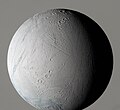File:PIA06208.jpg

Original file (1,013 × 930 pixels, file size: 84 KB, MIME type: image/jpeg)
| This is a file from the Wikimedia Commons. Information from its description page there is shown below. Commons is a freely licensed media file repository. You can help. |
Summary
| DescriptionPIA06208.jpg |
English: Original Caption Released with Image:
During its very close flyby on March 9, 2005, the Cassini spacecraft captured this false-color view of Saturn's moon Enceladus, which shows the wide variety of this icy moon's geology. Some geological regions on Enceladus are old and retain large numbers of impact craters; younger areas exhibit many generations of tectonic troughs and ridges. Subtle differences in color may indicate different ice properties, such as grain sizes, that will help unravel the sequence of geologic events leading to the current strange landscape. This false-color view is a composite of individual frames obtained using filters sensitive to green (centered at 568 nanometers) and infrared light (two infrared filters, centered at 752 and 930 nanometers respectively). The view has been processed to accentuate subtle color differences. The atmosphere of Saturn forms the background of this scene (its color has been rendered grey to allow the moon to stand out). The Sun illuminates Enceladus from the left, leaving part of it in shadow and blocking out part of the view of Saturn. This view shows the anti-Saturn hemisphere, centered nearly on the equator. The images comprising this view were taken with the Cassini spacecraft narrow-angle camera at a distance of approximately 94,000 kilometers (58,000 miles) from Enceladus and at a Sun-Enceladus-spacecraft, or phase, angle of 48 degrees. Resolution in the image is about 560 meters (1,800 feet) per pixel. The Cassini-Huygens mission is a cooperative project of NASA, the European Space Agency and the Italian Space Agency. The Jet Propulsion Laboratory, a division of the California Institute of Technology in Pasadena, manages the mission for NASA's Science Mission Directorate, Washington, D.C. The Cassini orbiter and its two onboard cameras were designed, developed and assembled at JPL. The imaging team is based at the Space Science Institute, Boulder, Colo. |
| Date | Taken on 9 March 2005 |
| Source | http://photojournal.jpl.nasa.gov/catalog/pia06208 |
| Author | NASA/JPL/Space Science Institute |
This image or video was catalogued by Jet Propulsion Laboratory of the United States National Aeronautics and Space Administration (NASA) under Photo ID: PIA06208. This tag does not indicate the copyright status of the attached work. A normal copyright tag is still required. See Commons:Licensing. Other languages:
العربية ∙ беларуская (тарашкевіца) ∙ български ∙ català ∙ čeština ∙ dansk ∙ Deutsch ∙ English ∙ español ∙ فارسی ∙ français ∙ galego ∙ magyar ∙ հայերեն ∙ Bahasa Indonesia ∙ italiano ∙ 日本語 ∙ македонски ∙ മലയാളം ∙ Nederlands ∙ polski ∙ português ∙ русский ∙ sicilianu ∙ slovenščina ∙ Türkçe ∙ українська ∙ 简体中文 ∙ 繁體中文 ∙ +/− |
Licensing
| Public domainPublic domainfalsefalse |
| This file is in the public domain in the United States because it was solely created by NASA. NASA copyright policy states that "NASA material is not protected by copyright unless noted". (See Template:PD-USGov, NASA copyright policy page or JPL Image Use Policy.) |  | |
 |
Warnings:
|
Original upload log
Transferred from en.wikipedia to Commons using For the Common Good.
| Date/Time | Dimensions | User | Comment |
|---|---|---|---|
| 06:52, 27 April 2005 | 1,013 × 930 (85,819 bytes) | w:en:Atitarev (talk | contribs) | (Original Caption Released with Image: During its very close flyby on March 9, 2005, the Cassini spacecraft captured this false-color view of Saturn's moon Enceladus, which shows the wide variety of this icy moon's geology. Some geological regions on En) |
Captions
Items portrayed in this file
depicts
9 March 2005
File history
Click on a date/time to view the file as it appeared at that time.
| Date/Time | Thumbnail | Dimensions | User | Comment | |
|---|---|---|---|---|---|
| current | 06:16, 26 August 2012 |  | 1,013 × 930 (84 KB) | Bulwersator | Transferred from en.wikipedia: see original upload log above |
File usage
Global file usage
The following other wikis use this file:
- Usage on fr.wikipedia.org
